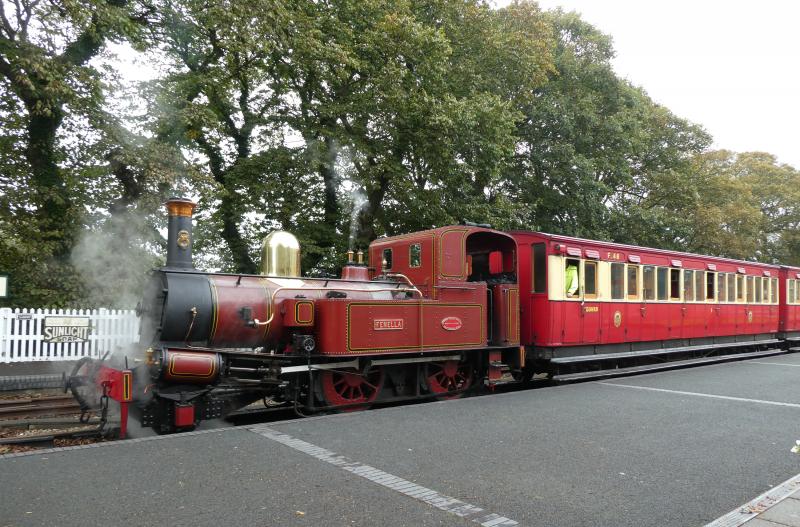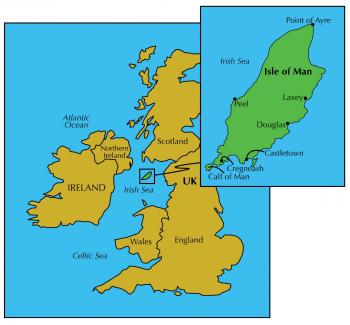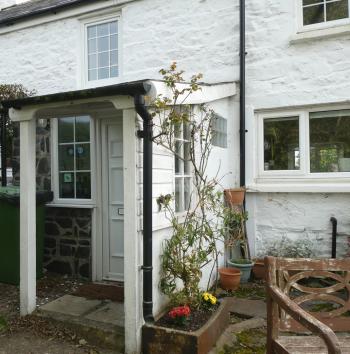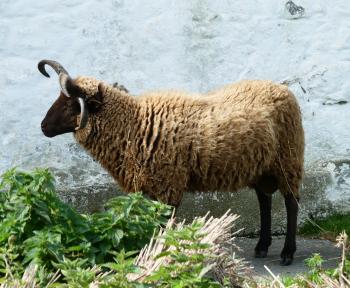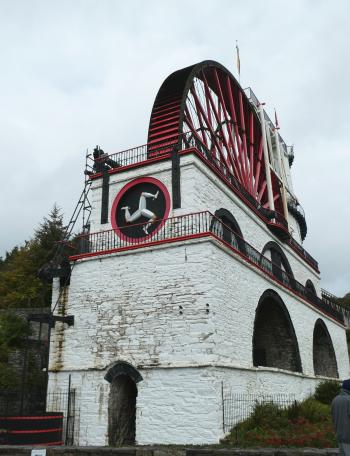Finding lots of interest on a self-drive tour of the Isle of Man
This article appears on page 6 of the August 2021 issue.
A few years ago, while we were exploring the British Channel Islands together, our friend Mary said, “Let’s go to the Isle of Man next!” “Why?” we asked. “It’s just Manx cats and motorcycle races, right?” But Mary said there was a lot more.
In 2019, the time had come, so we called Mary and off we went!
The Isle of Man (IOM), located in the Irish Sea midway between Ireland and England, is not large — only about 33 by 13 miles — but it’s packed with interesting surprises. We spent eight days there in September, making sure we didn’t visit during the annual motorcycle races that take place in May/June. At that time, the island is crowded, it’s difficult to find a place to stay, and many of the roads are closed off for the racers.
Getting there
We took a nonstop Aer Lingus flight from San Francisco to Dublin, then hopped a little puddle-jumper plane across to IOM. It’s not the easiest place to get to, and, depending on where you’re coming from, connections may require long wait times. Travel options are constantly changing, especially now, but there are usually flights from nearby hubs like Liverpool, Belfast and Dublin.
Passenger ferries also depart from ports in those cities, but not all are year-round, and weather delays are common.
Flights land at Ronaldsway Airport, just outside Castletown at the southern end of the island, while ferries arrive at the deepwater port of Douglas, the island’s current capital, on the east coast.
Our travel agent, Tim Todd of TEI Tours & Travel (Pleasant Hill, CA; 925/825-6014, teiglobal.com), arranged our flights, rental car and travel insurance, as he has done for us many times before, and everything worked out very well.
We picked up our rental car from Athol Car Hire (athol.co.im) at the airport on arrival. We’d reserved an SUV, which is fairly expensive anywhere in the British Isles and especially so on this small island, but with five travelers for part of the time (we were meeting two more friends) and luggage, we needed a good-size vehicle. We’d also specified automatic transmission, also not so easy to find there. (From decades of experience, we knew that it was difficult enough remembering to drive on the left without having to think about a clutch and shifting gears, too.)
We paid $589 for the vehicle for eight days, including full insurance coverage and a second-driver charge.
Before leaving home, we’d checked with the Isle of Man Constabulary (iompolice.im) to see if our California disabled parking placard would be accepted there. (It’s the local option outside the US, so you need to ask.) It was, which made parking much easier.
Island life
We rented a 3-bedroom, 2-bath cottage on the southern end of the island, just outside the old island capital of Castletown.
With pleasant and helpful owners, Cronk Darragh Cottage (Ballakeighan Corner, Castletown; phone +01624 822050, cronkdarraghcottage.com) was charming, well equipped and in a great location at a crossroads.
We paid £576 (approximately $800) for eight nights. Divided among several people, the per-person price was much less than at a hotel, especially with having a kitchen and laundry facilities. We enjoyed all the space and privacy as well as the garden.
We ate and drank surprisingly well on the Isle of Man. One of the local specialties is queen scallops (“queenies”), harvested in Manx waters, which I enjoyed at every opportunity. We ate lots of fresh fish and had plenty of good pub food too. (Our favorite local pub was The Viking on Station Road.) We found an excellent Italian place, Tuscany Restaurant (31 Malew St.), but, unfortunately, discovered it only on our last day on the island.
Perfectly adequate wine was widely available, and the good local beers made the beer drinkers in our group very happy.
Because we had a third bedroom in the cottage, we invited our Scottish friends Julie and Tony to join us, and they flew over from Edinburgh for a few days. They had never been to IOM, so it was fun to show them around this nearby nation.
The official emblem of the Isle of Man is the Three Legs of Man, an ancient symbol representing the island’s long heritage, from Neolithic times through the periods of rule by the Vikings, the Scots and then the English. Through it all, the Manx have retained a sturdy independence and a unique culture. They have their own parliament, Tynwald, and their own language, though few now speak it. The island also has its own banknotes, coins and postage stamps.
Notable sights
A good introduction to the island can be found at the excellent Manx Museum (manxnationalheritage.im) in Douglas. The museum also manages Cregneash Village, near the south end of the island. A living museum, Cregneash illustrates 19th-century life in a traditional Manx crofting village, and it is one of the places where you are sure to see Manx cats and Manx Loaghtan sheep.
Manx cats are not thought to be native to the island, but they’ve been there for very a long time, probably brought by Vikings in the 8th or 9th century. Their distinctive tailless quality may have become established through deliberate breeding or perhaps was a result of the limited gene pool on the island. Not all the cats are totally tailless, though; some have short, stubby tails. A charming little book, “A De-Tailed Account of Manx Cats” by Sara Goodwins, tells their story.
The Loaghtan are a rare breed of small and sturdy mountain sheep that are native to the island. They are notable for the rams and ewes each having four or six horns.
Their brown wool is spun into yarn and woven on the island, and the Laxey Woollen Mills (laxeywoollenmills.com) carry a wonderful variety of products made from this wool. (Yes, we bought our souvenirs there.)
Mining was once a major industry on the Isle of Man (although most of the scars from mining have now vanished), and just outside the town of Laxey is the magnificent Laxey Wheel. The world’s largest working waterwheel, it was built to pump water from the mines.
After touring the wheel, you can go for a pleasant walk in the beautiful nearby gardens and glen.
The island is a great place for walking. Across the road from Cregneash Village is a path that goes up to Meayll Circle, a ring of burial chambers atop a hill that offers a great view.
A useful little book, “Walking on the Isle of Man” by Terry Marsh, lays out a number of interesting walks, both short and long.
A few highlights
Another “must do” is taking a ride on one (or more) of the IOM’s vintage trains. If you are staying in Castletown, you can take the steam train into Douglas and walk to the Manx Museum from the station. Or, from Laxey, you can ride the original tramcars up to the peak of Snaefell, the only real mountain on the island.
One of our trip highlights was a boat ride around the Calf of Man, the islet off the south end of the island, which provided stunning views and an excellent commentary on the area’s wildlife, history and geology.
Also not to be missed are the old capital of Castletown and its Castle Rushen; the Point of Ayre, on the north coast, with views of Scotland; the town of Peel and its castle, and Tynwald Hill, the site of the island’s ancient parliament.
Bird-watching is another enjoyable activity there. Bud has spent a lot of time birding in the British Isles, so many Manx birds were already familiar, but he never misses a chance to see more. He contacted local birders through the organization Birding Pal (birdingpal.org), and the head of the local ornithological society was good enough to take him out birding on two days.
The very first stop on the first day produced about half a dozen species and then, later, a prize new bird: a purple sandpiper. Bud was happy to get the new bird for his life list, plus he acquired Manx banknotes, coins and postage stamps, all coveted items for his collections.
Final thoughts
Before visiting a new area, we always like to read all we can about it, including any works of fiction set there, to get a feeling for the place. Among the books we read that were set on the island were a number of mysteries by George Bellairs featuring his Inspector Littlejohn. Diana Xarissa has also written books set on the island.
Leaving the Isle of Man, Mary flew back home, but we continued on for other adventures. After spending a day in Edinburgh with some other friends, we left for the Continent to explore Belgium and Luxembourg by train. But that’s a story for another time….

